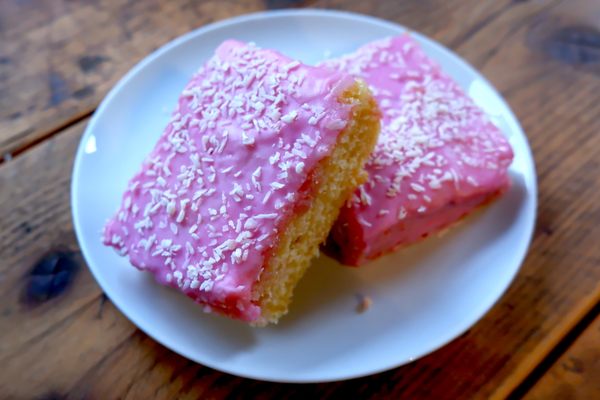Flódni is an elaborate, multi-layer cake consisting of four different fillings—first plum jam, then walnut, apple, and poppy seed—each between sheets of pastry. It might sound like the dessert version of Turducken, but this Hungarian-Jewish treat is no fleeting trend created as a social media–friendly novelty.
The roots of flódni go back to medieval France and Germany. The word itself comes from the German fladen, a flat thin cake. According to a researcher at Tel Aviv University, the earliest reference to a Jewish flat cake also called fladen dates back to the 10th century. At that time, it was typically made with cheese. Today’s flódni, however, was developed by the Jews of the Carpathian Basin, who added more layers and fruit fillings.
The labor-intensive dessert has been one of the most potent symbols of Hungarian-Jewish cooking since the 19th century, when it was often enjoyed during Purim, the Jewish feast day that celebrates Queen Esther, who thwarted the royal official Haman’s plan to annihilate the Jews in the Achaemenid Empire.
All the fillings are cooked separately. If a flódni is to have any credibility, the apples should be steamed in wine, then slightly sweetened with honey; the poppy seed mixture must be made with grated lemon peel; the walnuts should be mixed with raisins and wine; and the plum jam needs to be thick enough to stay in place between the pastry layers.
There are several myths around the meaning of flódni’s multiple layers. One holds that the four fillings represent the four seasons of the year. Another posits that, with its flavors of tart, bitter, and sweet melding together, the pastry symbolizes the hope for peaceful unity of people of different religions and ethnicities. Some say the dessert’s slightly sour and bitter flavors hint at the historic challenges to this unity.
“It’s a rich past and present of cultural layers that build on each other and organically merge, a blend of Jewish and Hungarian traditions,” says Mátyás Király, an assistant archivist at the Hungarian Jewish Archives in Budapest. “Each layer can be enjoyed separately, but for full effect it is best to consume them together.”
Several cafés, especially in Budapest’s District VII, once a predominantly Jewish neighborhood, claim to have made the original recipe. But most flódni experts question these claims, as the treats’ roots stretch back into home kitchens, rather than stores or restaurants. As Tamás Raj, the former chief rabbi of Budapest, once said, “The real flódni is not even similar to what you can get in the confectionery under the name of flódni.” He then cast doubt on a single, definitive recipe, adding, “We don’t write a recipe, because there are as many houses as there are customs.”
Yet some of the flódni sold in cafés actually come from old family recipes, including Raj’s wife’s version, which became the most famous in Budapest thanks to their daughter, Rachel. Until it closed in 2021, Rachel Raj’s Budapest pastry shop—Rachel Raj’s Cake Salon—was a magnet for locals and visitors looking to try the signature cake.
When she started her business, Raj set out to resurrect classics of the Jewish Hungarian kitchen—and to spread knowledge of Jewish traditions. (Before World War II, a quarter of the population of Budapest was Jewish.) In doing so, she made flódni a symbol of 21st-century Jewish Hungary while also attracting non-Jewish fans. Flódni has even crossed religious circles and is now eaten by families of all faiths, including as a Christmas treat.
Though Raj’s flódni disappeared with the closing of her shop, many now tout Juci Vámos as Budapests’s best flódni maker. Vámos started baking a version of her mother’s recipe in her kitchen and, through word of mouth, her small business has grown into a supplier to some of the top restaurants and food shops in Budapest.
Where to Try It
-
Juci Vámos’s bakery is located in the MOM Park shopping center.
-
Rosenstein Website
Mosonyi utca 3, Budapest, 1087, HungaryAn iconic Budapest restaurant offering classic Jewish-Hungarian food, including matzo ball soups, cholent stew, and, of course, flódni.















